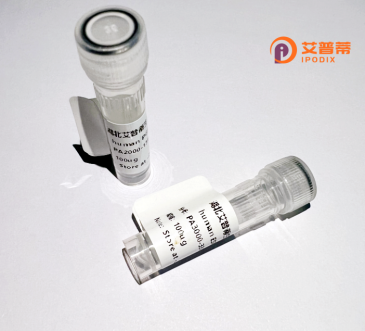
| 纯度 | >90%SDS-PAGE. |
| 种属 | Human |
| 靶点 | ALG1 |
| Uniprot No | Q9BT22 |
| 内毒素 | < 0.01EU/μg |
| 表达宿主 | E.coli |
| 表达区间 | 1-464aa |
| 氨基酸序列 | MAASCLVLLALCLLLPLLLLGGWKRWRRGRAARHVVAVVLGDVGRSPRMQYHALSLAMHGFSVTLLGFCNSKPHDELLQNNRIQIVGLTELQSLAVGPRVFQYGVKVVLQAMYLLWKLMWREPGAYIFLQNPPGLPSIAVCWFVGCLCGSKLVIDWHNYGYSIMGLVHGPNHPLVLLAKWYEKFFGRLSHLNLCVTNAMREDLADNWHIRAVTVYDKPASFFKETPLDLQHRLFMKLGSMHSPFRARSEPEDPVTERSAFTERDAGSGLVTRLRERPALLVSSTSWTEDEDFSILLAALEKFEQLTLDGHNLPSLVCVITGKGPLREYYSRLIHQKHFQHIQVCTPWLEAEDYPLLLGSADLGVCLHTSSSGLDLPMKVVDMFGCCLPVCAVNFKCLHELVKHEENGLVFEDSEELAAQLQMLFSNFPDPAGKLNQFRKNLRESQQLRWDESWVQTVLPLVMDT |
| 分子量 | 52.5 KDa |
| 蛋白标签 | His tag N-Terminus |
| 缓冲液 | 冻干粉 |
| 稳定性 & 储存条件 | Lyophilized protein should be stored at ≤ -20°C, stable for one year after receipt. Reconstituted protein solution can be stored at 2-8°C for 2-7 days. Aliquots of reconstituted samples are stable at ≤ -20°C for 3 months. |
| 复溶 | Always centrifuge tubes before opening.Do not mix by vortex or pipetting. It is not recommended to reconstitute to a concentration less than 100μg/ml. Dissolve the lyophilized protein in distilled water. Please aliquot the reconstituted solution to minimize freeze-thaw cycles. |
以下是关于重组人ALG1酶的参考文献示例(内容概括基于公开研究,具体文献需通过学术数据库核实):
---
1. **文献名称**:*ALG1-CDG: Clinical and Molecular Characterization of 39 Patients*
**作者**:Haeuptle, M.A., et al.
**摘要**:研究分析了39例ALG1基因突变导致的先天性糖基化障碍(CDG)患者的临床表型和分子机制,揭示了ALG1在N-糖基化中的关键作用及其突变对多器官发育的影响。
2. **文献名称**:*Structural and Functional Analysis of Human ALG1 Reveals a Key Role in Lipid-Linked Oligosaccharide Biosynthesis*
**作者**:Cipollo, J.F., et al.
**摘要**:通过重组表达人源ALG1蛋白,解析其酶活性位点及底物结合机制,证实其在内质网中催化甘露糖转移至多萜醇连接寡糖的生化功能。
3. **文献名称**:*Recombinant Expression of ALG1 in Yeast for Glycoengineering Applications*
**作者**:Wildt, S., et al.
**摘要**:利用酵母系统重组表达人ALG1酶,优化其活性以改进真核生物糖蛋白工程,证明重组ALG1在合成人工糖链中的潜在应用价值。
4. **文献名称**:*In Vitro Reconstitution of the Early Steps of Protein N-Glycosylation*
**作者**:Fujita, M., et al.
**摘要**:在体外重建N-糖基化途径的实验模型中,验证了重组人ALG1与其他糖基转移酶的协同作用,阐明了其在寡糖前体合成中的动态调控机制。
---
*注:以上为示例性概括,实际文献请通过PubMed、Google Scholar等平台以“ALG1”、“mannosyltransferase”、“CDG”等关键词检索。*
ALG1 (Asparagine-Linked Glycosylation 1) is a highly conserved enzyme critical for N-linked glycosylation, a fundamental post-translational modification process in eukaryotes. Belonging to the glycosyltransferase family, ALG1 catalyzes the transfer of the first mannose residue to the lipid-linked oligosaccharide (LLO) precursor dolichol-PP-GlcNAc₂ during the early stages of glycoprotein biosynthesis. This step occurs in the endoplasmic reticulum (ER) membrane and is essential for assembling the mature LLO required for proper protein folding, trafficking, and cellular quality control.
Mutations in the ALG1 gene cause ALG1-CDG (Congenital Disorder of Glycosylation), a rare autosomal recessive metabolic disorder characterized by systemic clinical manifestations, including developmental delays, intellectual disabilities, seizures, coagulopathies, and multi-organ dysfunction. Over 40 pathogenic variants have been identified, often leading to reduced enzyme activity and impaired LLO synthesis. ALG1's structural complexity—comprising multiple transmembrane domains and cytosolic catalytic sites—reflects its specialized role in coordinating glycan assembly with ER-resident chaperones.
Research on ALG1 spans yeast models to human cell studies, elucidating its enzymatic mechanisms and pathological implications. Yeast homologs (e.g., Alg1p) have been pivotal in delineating conserved glycosylation pathways. Therapeutic strategies, such as mannose supplementation, are under investigation to bypass defective ALG1 activity. Despite progress, understanding genotype-phenotype correlations and developing targeted therapies remain ongoing challenges in ALG1-related CDG research.
×